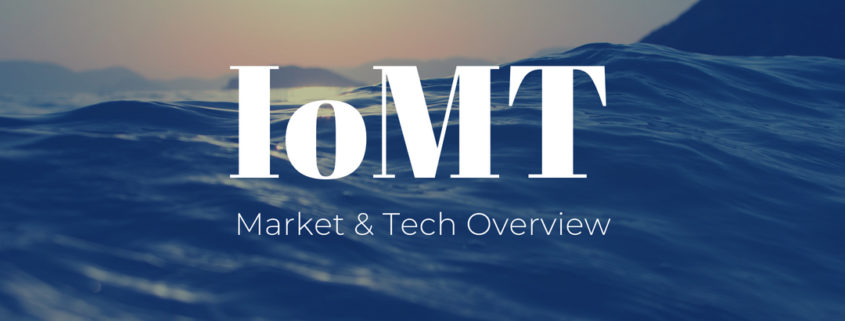What is Internet of Medical Things (IoMT)?
Today it is impossible to imagine the healthcare industry without modern technologies. Artificial intelligence, wearables, drones, robots are gradually becoming a familiar health tool. Modern technologies are used to diagnose, treat, monitor, conduct operations, transport medicines and blood.
What is IoMT?
The Internet of Medical Things is the connected system of medical devices and applications that collect data which is provided to healthcare IT systems through online computer networks. According to Allied Market Research today there are 3.7 million medical devices in use that are connected to and collect information to provide a better healthcare service based on it.
Problems and benefits of IoMT
There are several realities that caused an incredible IoMT growth. The first one is an increasing amount of elderly people (according to United Nations projections, by 2025, 1.2 billion of the 8 billion people on earth will be elderly) who need a good treatment that can be achieved easier with various wearables and medical devices. IoMT doesn’t aim to replace doctors or medical care. In contrary, they are going to become real friends of doctors helping to collect health information more easily and to increase its quality. Government regulatory policies create favorable conditions for technologies implementation in the healthcare process which can decrease the cost of healthcare services. Since the cost of some medical diagnostics are pretty expensive but can be partially replaced by wearables that many people can afford today. But there are several challenges for achieving these goals such as a technical side of the question. These goals require the transformation of the whole healthcare industry and also it has to be secure and easy to use. In order to provide highly sensitive and confidential data with high security to combat cyber attacks, employing blockchain technology could be used. Using a combination of artificial intelligence and blockchain technology, companies could keep all the data loads secure.
Live IoMT solutions
The most advanced methods of diagnosis are the use of artificial intelligence. With the help of machine learning technologies, the diagnosis automatically will be the next step in the transformation in the healthcare industry.
Beyond Verbal is a company from Israel, which in September 2016 presented a project of a system based on artificial intelligence. The task of the system is to diagnose diseases by voice. It’s about recognizing intonation and other nuances that a person can not recognize by ear. For the testing of the system, the developers proposed AI to analyze more than 2.5 million audio recordings with voices in 40 different languages.
In February 2017, experts from North Carolina developed a miniature wireless device. The device should remotely diagnose the physical health of soldiers and athletes. The sensor of the elastic polymer material is attached to the wrist or chest. The device controls the electrical properties of the skin. These properties vary depending on the level of perspiration of a person. The received data is sent to the owner’s tablet or smartphone. Scientists said that the sensor controls the hydration of the skin, which means it helps to protect people working in hot conditions, improve the physical training of athletes, etc.
In May 2017, Perm scientists announced the creation of a system for diagnosing cardiovascular diseases, based on a neural network and the method of mathematical freezing. The database was provided to work effectively and test the system from the emergency cardiology department of the local hospital. The network is capable of self-learning and successfully diagnoses. It uses data on previous illnesses, history of relatives’ diseases, pulse data, pressure. The system takes into account 69 indicators.
In August 2017, China presented an auxiliary system based on AI technologies for setting a clinical diagnosis. To analyze 100 case histories, the system takes 4.8 seconds or 0.05 seconds for each story. Diagnoses of AI on 98% coincide with those that are carried by qualified medical staff. To create the system, millions of patient records were used. The accuracy of the machine diagnosis is 20% higher than that supplied by the doctor.
In December 2016, Israel presented a prototype of a bracelet with an NFC chip, which allowed emergency assistance to wounded soldiers in combat. The device stores data about the patient’s health, information about the treatment already provided, photos of the patient’s wounds and GPS coordinates of the places where the soldier was injured. Developers will test the bracelet in order to understand whether it is reasonable to organize mass production.
Scientists from the University of Tokyo have developed an artificial intelligence system for the treatment of phobias and post-traumatic stress. This required finding the brain classes responsible for the memory of fear. Therefore, 17 volunteers with the help of current discharges “created” the memory of fear. AI quickly and accurately determined the knowledge of the brain responsible for this memory. Now the doctors have built an effective treatment program.
Wearable devices are already monitoring the indicators of physical activity. For example, a device developed by the UCB and Byteflies Sensor Dot will notify patients about an impending epileptic seizure. The sensor makes several different measurements to accurately predict the time of the impending attack.
In May 2017, Apple CEO Tim Cook (Tim Cook) tested a device similar to a glucometer. Now, in order to measure the sugar level in measles, people suffering from diabetes need to pierce their fingers. Wearable devices, if their error in determining the blood sugar level will be minimal, can also be used for monitoring, without having to take blood sampling.
In November 2016 DaVinci’s robotic surgical system took part in more than 450 operations. The system is installed in the Regional Clinical Oncology Center and the Research Institute of the Regional Hospital of the Ministry of Health in Krasnodar region. The system provides a 3D image of the operating field and allows you to transfer the movements of the surgeon to their manipulators with high accuracy. Thus, the doctor can work with tools, remotely, using joysticks and a three-dimensional image in a tenfold increase.
Market forecast
According to Tractica analysts, the world’s revenue from the sale of healthcare software and services will more than double from $13.5 billion in 2016 to $28.2 billion in 2021. Analysts at Allied Market Research reported the global mobile healthcare market is estimated at $10.5 billion in 2014. According to forecasts of Berg Insight: 7.1 million patients in 2016 were observed remotely, and by 2021 the number of such patients will reach 50.2 million.
The number of mHealth devices with integrated 2G / 3G / 4G modules increased from 3.0 million in 2015 to 4.9 million in 2016.
According to Tractica forecasts, shipments of medical robots will grow from 3.4 thousand in 2016 to 10.5 thousand by 2021. It is expected that sales of medical robots will increase from $1.7 billion to $2.8 billion by 2021.
Therefore, IoT is likely to change the whole healthcare system and surely will bring positive results in it. It’s really important that modern technologies are used in such an important field as healthcare. Hopefully, all these solutions will decrease the number of people suffering from different diseases and will rise life expectancy. So we are lucky to face these improvements and enjoy a healthy and full life.

Download a FREE whitepaper to understand how to innovate with Blockchain.


Leave a Reply
Want to join the discussion?Feel free to contribute!